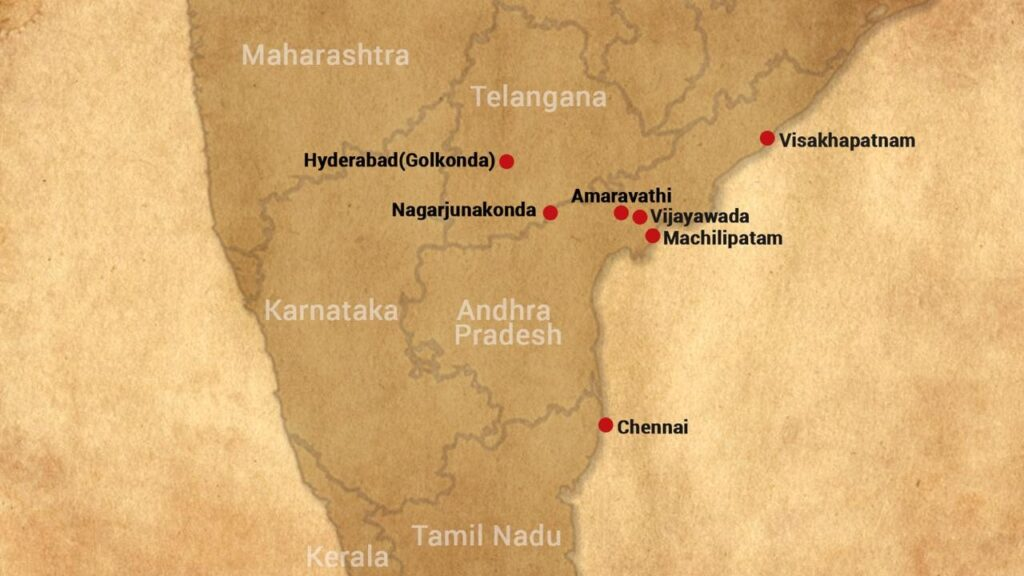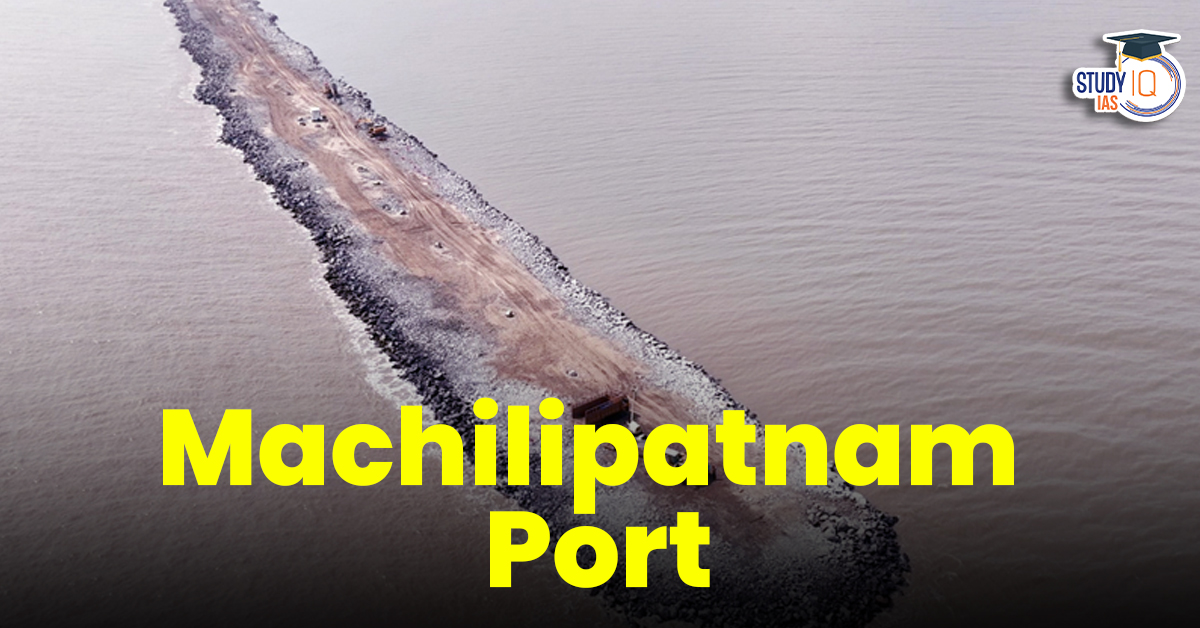Table of Contents
Context: Nearly 48% of the Machilipatnam Greenfield Port is complete, with operations expected by end-2026.
About Machilipatnam Port (Masulipatnam / Bandar)
- Coastal city in Krishna district, Andhra Pradesh.
- Situated at the mouth of the Krishna River along the Bay of Bengal.
- Flourished during the Satavahana era (1st century AD).
- Golconda Sultanate Era: Gained prominence for muslin and textile exports to Persia, Europe, and Southeast Asia.
- European Trading Posts: Dutch, British, and French established factories in the 17th century.

Machilipatnam Port, also known historically as Masulipatnam or Bandar, is a coastal city in Andhra Pradesh, India, with a rich maritime history dating back to ancient times. After centuries of decline, the port is finally undergoing a major revival.
Historical Significance of Machilipatnam Port
Machilipatnam was an important trading centre as early as the 1st century AD, perhaps during the period of the Satavahana dynasty (2nd Century BC – 2nd Century AD), referred to as Maisolos or Masalia. It was a boom town as a centre of seaborne trade with Rome, China, Persia, and Southeast Asia. It was well known for its fine Muslin cloth, which was an important export.
In medieval times, it remained a major port under different local kingdoms such as the Bahamani, Vijayanagara, and Golconda. Under the Qutb Shahi dynasties, it was a centre for the global diamond trade (from the mythical Golconda mines) and Kalamkari fabrics.
European merchants, such as the Portuguese, Dutch, and British, erected their trading posts and factories there, as it had strategic and economic significance. The British East India Company established its first trading post on the Bay of Bengal in Machilipatnam in 1611. Yet, the result of natural disasters (such as ruinous cyclones in 1864) and changing British policies that benefited ports like Madras (Chennai) caused Machilipatnam’s role as a port to fade over time.
Current Development and Revival of Machilipatnam Port
For decades, the vision of restoring Machilipatnam Port has been on the cards with a promise that has been continuously rescheduled.
- Greenfield Port: A new greenfield deep-sea port is being built at Manginapudi in Machilipatnam, Krishna district.
- Developer: Megha Engineering and Infrastructure Ltd (MEIL), a part of India’s top infrastructure companies, is developing the project.
- Progress: It was about mid-July 2025 that about 48% of the work on building the new port had been done. About 1,250 workers work around the clock in two shifts to push the work forward.
- Projected Completion: The port should be operational by the end of 2026 (previously, some reports indicated October 2025, but the recent news is of completion in late 2026).
- Project Cost and Capacity (Phase 1): Phase 1 of the project will cost ₹5,155 crore and consist of four berths. It has an initial cargo capacity of 36 million tonnes per annum (MTPA) and can accommodate heavy ships with a weight of up to 80,000 tonnes.
- Expansion Capacity: There is also a plan in the master plan for future expansion of the port to 16 berths, which will enlarge its handling capacity considerably.
- Landlord Model: The port is being developed under the Landlord Model in which the government (Machilipatnam Port Development Corporation Ltd, a subsidiary of the AP Maritime Board) owns the port and private companies operate it.
- Engineering Challenges: The development entails huge engineering achievements, such as dredging 56 million cubic meters of sand to allow anchorage for huge vessels and constructing a 2.5 km long breakwater with 2.1 million tonnes of rocks. Special concrete blocks named tetrapods are also being used to safeguard the port against sea waves.
Economic Impact and Significance of Machilipatnam Port
The revival of Machilipatnam Port will be a big economic boost for Andhra Pradesh and Telangana.
- Gateway of Trade: It will be an important gateway for exports (coal, cement, pharma, fertilisers, containers) and imports, saving logistics time and cost for industries in the hinterlands of both states.
- Industrial Development: The government of Andhra Pradesh is intending to develop an industrial park covering 300 acres in Gilakaladindi with an emphasis on port-related industries such as aquaculture, processing of marine products, and traditional industries such as Kalamkari.
- Job Creation: The project is expected to create thousands of direct and indirect job opportunities for the local people.
- Regional Connectivity: The port’s geographical positioning and proposed connectivity through National Highway 216 and the Gudivada-Machilipatnam railway link will further establish its position as a major regional economic driver.
Following a long and arduous journey through many delays and shifts in contractors since 2007, Machilipatnam is set to reassert its traditional importance as a principal maritime centre on India’s eastern seaboard


 Birsa Munda Birth Anniversary 2025: Life...
Birsa Munda Birth Anniversary 2025: Life...
 Military Innovations of Afghans and Turk...
Military Innovations of Afghans and Turk...
 Self-Respect Movement, History, Objectiv...
Self-Respect Movement, History, Objectiv...

























